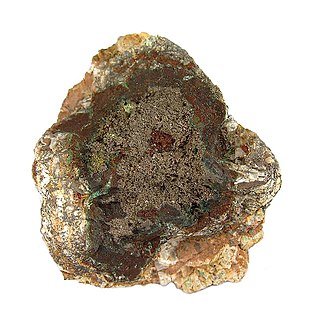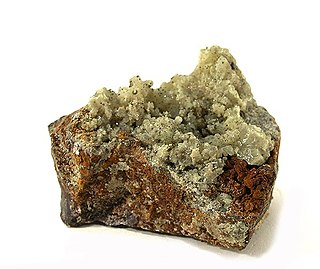 W
WAbhurite is a mineral of tin, oxygen, hydrogen, and chlorine with the formula Sn21O6(OH)14Cl16 or Sn3O(OH)2Cl2. It is named after its type locality, a shipwreck with tin ingots at Sharm Abhur, a cove near Jeddah in the Red Sea. Abhurite forms alongside other tin minerals like romarchite and cassiterite.
 W
WAnthonyite is a hydrous secondary copper halide mineral with chemical formula of Cu(OH,Cl)2•3(H2O).
 W
WAntozonite is a radioactive fluorite variety first found in Wölsendorf, Bavaria, in 1841, and named in 1862.
 W
WArtroeite (PbAlF3(OH)2) is a mineral found in Arizona. It is named for the late American chemist Arthur Roe (1912–1993).
 W
WAtacamite is a copper halide mineral: a copper(II) chloride hydroxide with formula Cu2Cl(OH)3. It was first described for deposits in the Atacama Desert of Chile in 1801 by D. de Fallizen. The Atacama Desert is also the namesake of the mineral.
 W
WBismoclite is a bismuth oxohalide mineral with formula BiOCl. It is the naturally occurring form of bismuth oxychloride. The name was derived from its chemical constituents. It is a secondary bismuth mineral first thought to be composed of bismuthyl ions (BiO+) and chloride anions, however, the existence of the diatomic bismuthyl ion is doubtful. It is a member of the matlockite group.
 W
WBotallackite, chemical formula Cu2(OH)3Cl is a secondary copper mineral, named for its type locality at the Botallack Mine, St Just in Penwith, Cornwall. It is polymorphous with atacamite, paratacamite and clinoatacamite.
 W
WBromyrite or bromargyrite is a natural mineral form of silver bromide found mainly in Mexico and Chile. Hardness is 1.5 to 2. Related are chlorargyrite and iodyrite.
 W
WCadwaladerite is a rare aluminium halide mineral with formula: AlCl(OH)2·4(H2O). It was reported for an amorphous substance associated with sulfate minerals and embedded in a halite crystal cluster. Its status is uncertain due to inadequate data. It was first described in 1941 for an occurrence in mine dumps of the Victoria Segunda mine Cerros Pintados, Iquique province, Tarapacá Region, Chile. It was named for Charles Meigs Biddle Cadwalader, president of the Academy of Natural Sciences. Lesukite was discredited (IMA2018-H).
 W
WChallacolloite, KPb2Cl5, is a rare halide mineral. It crystallizes in the monoclinic system and occurs as white fumarolic encrustations on lava. It occurs as intergrowths with cotunnite.
 W
WChlorargyrite is the mineral form of silver chloride (AgCl). Chlorargyrite occurs as a secondary mineral phase in the oxidation of silver mineral deposits. It crystallizes in the isometric - hexoctahedral crystal class. Typically massive to columnar in occurrence it also has been found as colorless to variably yellow cubic crystals. The color changes to brown or purple on exposure to light. It is quite soft with a Mohs hardness of 1 to 2 and dense with a specific gravity of 5.55. It is also known as cerargyrite and, when weathered by desert air, as horn silver. Bromian chlorargyrite is also common. Chlorargyrite is water-insoluble.
 W
WChloroxiphite is a rare olive green to pistacio green lead copper halide mineral with formula: Pb3CuO2Cl2(OH)2.
 W
WCotunnite is the natural mineral form of lead(II) chloride with formula PbCl2.
 W
WHåleniusite-(La), chemical formula (La,Ce)OF. is a yellow isometric mineral. It has a dull, earthy lustre. The geological setting of håleniusite-(La) is in vugs and leaching zones of massive ferriallanite-(Ce), intimately intergrown with cerite-(Ce) and bastnäsite-(La).
 W
WHydrohalite is a mineral that occurs in saturated halite brines at cold temperatures. It was first described in 1847 in Dürrnberg, Austria. It exists in cold weather.
 W
WIodyrite or iodargyrite is a natural mineral form of silver iodide.
 W
WKremersite is a rare mineral which is a hydrated multiple chloride of iron, ammonium and potassium with the formula: (NH4,K)2FeCl5·H2O. Kremersite is a brown-red to orange mineral that crystallizes in the orthorhombic system. It is a water-soluble mineral that is found around volcanic fumaroles. Occurs at Vesuvius, Italy and Mount Etna, Sicily. It was discovered in 1853 and named for the German chemist, Peter Kremers (born 1827).
 W
WLaurionite is a lead halide mineral. It forms colorless to white crystals in the orthorhombic crystal system and is dimorphous with paralaurionite, both members of the matlockite group.
 W
WNadorite is a mineral with the chemical formula PbSbO2Cl. It crystallizes in the orthorhombic crystal system and is brown, brownish-yellow or yellow in color, with a white or yellowish-white streak.
 W
WParalaurionite is a colorless mineral consisting of a basic lead chloride PbCl(OH) that is dimorphous with laurionite. It is a member of the matlockite group. The name is derived from para-, the Greek for "near", and laurionite, because of its polymorphic relationship to it. Bright, yellow tips of thorikosite can form on paralaurionite crystals and paralaurionite may also be intergrown with mendipite.
 W
WPerite is a mineral that has a general chemical formula of PbBiO2Cl. The name is given for Per Adolf Geijer, a Swedish economic geologist with the Geological Survey of Sweden, who discovered the mineral in 1960 outside of Langban, Sweden. Perite is orthorhombic, which means crystallographically, it contains three axes of two of equal length (the bases a and b) and one of a little longer or shorter length. All three bases intersect at a 90° angles. It belongs to the space group Cmcm {C2/m 2/c 21/m}. In terms of its optical properties, Perite is anisotropic which means the velocity of light varies depending on direction through the mineral (i.e. it is birefringent). Its calculated relief is 1.45-1.461, which is moderate. It is colorless in plane polarized light, and it is weakly pleochroic. Perite is found in areas near igneous extrusions in places like the Western United States, Southern Australia, and scattered around Europe.
 W
WRosenbergite is a mineral with the chemical formula AlF3·3H2O. It is a trihydrate of aluminium fluoride.
 W
WSellaite is a magnesium fluoride mineral with the formula MgF2. It crystallizes in the tetragonal crystal system typically as clear to white vitreous prisms. It may be fibrous and occur as radiating aggregates. It has a Mohs hardness of 5 to 6 and a specific gravity of 2.97 to 3.15. Refractive index values are nω = 1.378 and nε = 1.390.
 W
WTerlinguaite is the naturally occurring mineral with formula Hg2ClO. It is formed by the weathering of other mercury-containing minerals. It was discovered in 1900 in the Terlingua District of Brewster County, Texas, for which it is named. Its color is yellow, greenish yellow, brown, or olive green.
 W
WThomsenolite is a mineral with formula: NaCaAlF6·H2O. It is an alteration product of cryolite.
 W
WYttrocerite is a variety of the mineral fluorite with a chemical formula CaF2+(Y,Ce)F3. It is bluish red with isometric crystals and is named for the yttrium and cerium it contains. It has a Mohs hardness of 4-5. It has been found in Sweden, several states in the United States and Norway. It is not a mineral species approved by International Mineralogical Association.